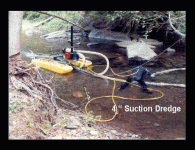aarthrj3811
Gold Member
Facts about Gold
Micron Gold
Sometimes folks who are interested in prospecting for gold in the western USA ask why, when the state of Nevada produces litterally tons of gold each year, that so little of it is in the form of placer nuggets. Its true, Nevada has a large number of gold mines and they produce some considerable amounts of gold, in fact, far more than any other state. It is also true that while Nevada does produce some nice placer gold, much of the Nevada gold is taken from big mines where the gold is microscopic - only a few microns in size. At most of these big mines, only a small percentage is large enough to be considered as "nugget" gold. As an example, Round Mountain, a large Nevada producer, produces about 3% of its gold as nuggets. The rest, 97% is too tiny to be placer. Most large Nevada mines produce 100% of their gold from deposits of micron sized, microscopic gold and produce no placer at all.
This stuff is all over the place…What we need to know about Micro gold is the signal strength of the deposits. Most of the deposits are small. Some of the larger accumulations can give off a signal that reads as much as 35 pounds of gold. It is very difficult to null this amount out….Always dig into a bucket. When the signal is no longer in your hole and is in your bucket you have it all…Save this material until the winter as it takes a lot of time to process.
Another thing to think about is what I call kickers…These are deposits on the surface. They are usually in spots where the rain has moved them…Signs of black sand on the surface is a dead give away…Just kick the spot and see if the signal disappears.
http://www.goldplacer.com/
Placer Gold
Placer mining (pronounced /ˈplæsər/, also /ˈpleɪsər/[1]) is the mining of alluvial deposits for minerals. This may be done by open-pit (also called open-cast mining) or by various forms of tunneling into ancient riverbeds. Excavation may be accomplished using water pressure (hydraulic mining), surface excavating equipment or tunneling equipment.
The name derives from Spanish, placer, meaning "sandbank." It refers to mining the precious metal deposits (particularly gold and gemstones) found in alluvial deposits—deposits of sand and gravel in modern or ancient stream beds. The metal or gemstones, having been moved by stream flow from an original source such as a vein, is typically only a minuscule portion of the total deposit. The containing material may be too loose to safely mine by tunneling. Where water under pressure is available, it may be used to mine, move, and separate the precious material from the deposit.
The best places to look for Placer Gold are…Near present day rivers and streams..You need to remember that Placer Gold only moves in the water at High Water or flood conditions. It will only drop out of the water when there is a low pressure condition. IE. Behind large boulders or rock outcroppings or the insides of bends.
Always look above the stream or river for flat spots that could be where the water was 1000’s of years ago..These are called “benches”…and are usually higher up the mountain….
In the Dessert look in Dry Sand washes where gold could have been move by flash flooding. Just again look for low pressure areas.
There are a lot of maps of Ancient Stream Beds and they are good places to look also.
http://www.gold-nuggets.org/finding-gold-nuggets-areas.htm
Gold Nuggets
The best areas for finding gold nuggets are those which are known for producing coarse gold. The term "coarse" is used to describe gold pieces which range in size from a wheat grain to many grams. Scanning with a metal detector is the most common, practical method for finding gold nuggets and other forms of gold.
Coarse gold did not occur in all gold fields, even when some were considered especially rich. In some areas of Australia the gold is fine and concentrated in crevices in bedrock and any gravel wash overlying this. A metal detector cannot pick up this fine gold sprinkled through sand and gravel, nor can it detect minute traces of gold still enclosed in quartz reef material.
Miners were supposed to register the weight and location of all gold nuggets found over a certain size, although this requirement was often resented by the diggers who probably avoided the directive whenever possible.
There were usually several phases of activity for finding gold nuggets on an alluvial (gold) field. Following the initial discovery, the area was 'rushed' by diggers from near and then far. These early arrivals would work with great speed, sinking hundreds or even thousands of shafts as long as possible to the place of the first finds. Sometimes only a small proportion of shafts dug would produce gold nuggets or any other gold. Those which did indicated the direction of the rich lead, or perhaps the reef from which the material was shed.
You should be aware of the fact that “nuggets” are a rare item…and also that when you find one there may be others near by….
I will try to come up with something about Gold Float and finding gold veins…
I am not an expert on Gold so if you have anything else please put it on here...Art
Micron Gold
Sometimes folks who are interested in prospecting for gold in the western USA ask why, when the state of Nevada produces litterally tons of gold each year, that so little of it is in the form of placer nuggets. Its true, Nevada has a large number of gold mines and they produce some considerable amounts of gold, in fact, far more than any other state. It is also true that while Nevada does produce some nice placer gold, much of the Nevada gold is taken from big mines where the gold is microscopic - only a few microns in size. At most of these big mines, only a small percentage is large enough to be considered as "nugget" gold. As an example, Round Mountain, a large Nevada producer, produces about 3% of its gold as nuggets. The rest, 97% is too tiny to be placer. Most large Nevada mines produce 100% of their gold from deposits of micron sized, microscopic gold and produce no placer at all.
This stuff is all over the place…What we need to know about Micro gold is the signal strength of the deposits. Most of the deposits are small. Some of the larger accumulations can give off a signal that reads as much as 35 pounds of gold. It is very difficult to null this amount out….Always dig into a bucket. When the signal is no longer in your hole and is in your bucket you have it all…Save this material until the winter as it takes a lot of time to process.
Another thing to think about is what I call kickers…These are deposits on the surface. They are usually in spots where the rain has moved them…Signs of black sand on the surface is a dead give away…Just kick the spot and see if the signal disappears.
http://www.goldplacer.com/
Placer Gold
Placer mining (pronounced /ˈplæsər/, also /ˈpleɪsər/[1]) is the mining of alluvial deposits for minerals. This may be done by open-pit (also called open-cast mining) or by various forms of tunneling into ancient riverbeds. Excavation may be accomplished using water pressure (hydraulic mining), surface excavating equipment or tunneling equipment.
The name derives from Spanish, placer, meaning "sandbank." It refers to mining the precious metal deposits (particularly gold and gemstones) found in alluvial deposits—deposits of sand and gravel in modern or ancient stream beds. The metal or gemstones, having been moved by stream flow from an original source such as a vein, is typically only a minuscule portion of the total deposit. The containing material may be too loose to safely mine by tunneling. Where water under pressure is available, it may be used to mine, move, and separate the precious material from the deposit.
The best places to look for Placer Gold are…Near present day rivers and streams..You need to remember that Placer Gold only moves in the water at High Water or flood conditions. It will only drop out of the water when there is a low pressure condition. IE. Behind large boulders or rock outcroppings or the insides of bends.
Always look above the stream or river for flat spots that could be where the water was 1000’s of years ago..These are called “benches”…and are usually higher up the mountain….
In the Dessert look in Dry Sand washes where gold could have been move by flash flooding. Just again look for low pressure areas.
There are a lot of maps of Ancient Stream Beds and they are good places to look also.
http://www.gold-nuggets.org/finding-gold-nuggets-areas.htm
Gold Nuggets
The best areas for finding gold nuggets are those which are known for producing coarse gold. The term "coarse" is used to describe gold pieces which range in size from a wheat grain to many grams. Scanning with a metal detector is the most common, practical method for finding gold nuggets and other forms of gold.
Coarse gold did not occur in all gold fields, even when some were considered especially rich. In some areas of Australia the gold is fine and concentrated in crevices in bedrock and any gravel wash overlying this. A metal detector cannot pick up this fine gold sprinkled through sand and gravel, nor can it detect minute traces of gold still enclosed in quartz reef material.
Miners were supposed to register the weight and location of all gold nuggets found over a certain size, although this requirement was often resented by the diggers who probably avoided the directive whenever possible.
There were usually several phases of activity for finding gold nuggets on an alluvial (gold) field. Following the initial discovery, the area was 'rushed' by diggers from near and then far. These early arrivals would work with great speed, sinking hundreds or even thousands of shafts as long as possible to the place of the first finds. Sometimes only a small proportion of shafts dug would produce gold nuggets or any other gold. Those which did indicated the direction of the rich lead, or perhaps the reef from which the material was shed.
You should be aware of the fact that “nuggets” are a rare item…and also that when you find one there may be others near by….
I will try to come up with something about Gold Float and finding gold veins…
I am not an expert on Gold so if you have anything else please put it on here...Art


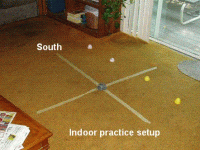
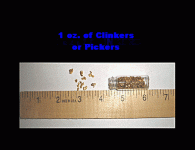
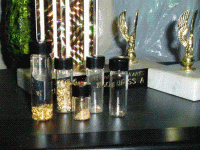
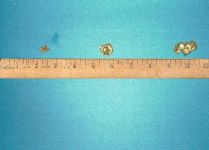
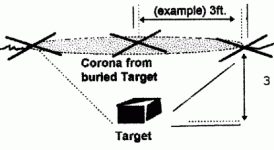
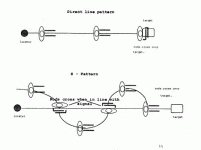
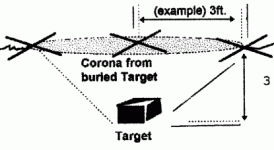
 ?
?